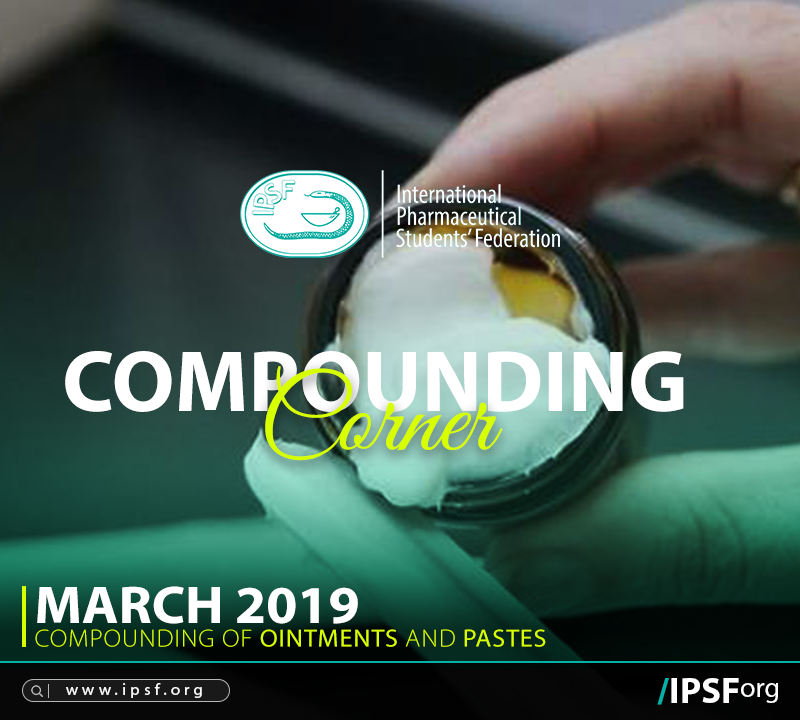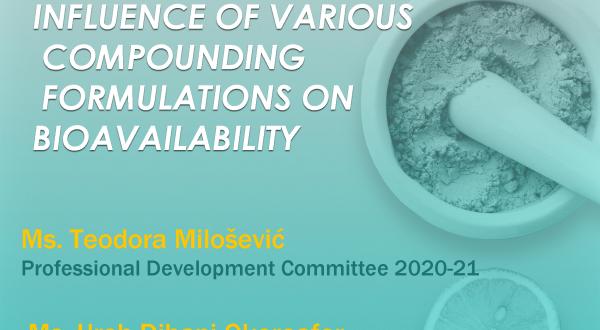
Compounding of Ointments and Pastes (March2019)
Ointments are used topically for several purposes such as protectants, antiseptics, emollients, antipruritics, keratolytics, and astringents, among others. Its vehicle or base is of prime importance, if the finished product is expected to function as any one of the above categories.
In the case of a protective ointment, it serves to protect the skin against moisture, air, sun rays, and other external factors. It is necessary that the ointment neither penetrates the human skin barriers nor should it facilitate the absorption of substances through such barrier. On the other hand, an antiseptic ointment is used to destroy or inhibit the growth of bacteria. Frequently bacterial infections are deeply seated; a base, which has the capacity to either penetrate or dissolve and release the medication effectively, is therefore desired. Ointments used for their emollient effect should be easy to apply, should be non-greasy, and should effectively penetrate the skin.
Pastes
Pastes are semi-solid preparations for external use. They consist of finely powdered medications combined with White Soft Paraffin BP, Liquid Paraffin BP, or a non-greasy base made from glycerol,
mucilages, or soaps.
Pastes contain a high proportion of powdered ingredients and, therefore, are normally very stiff. Because pastes are stiff, they do not spread easily, localizing drug delivery. This is particularly important, if the ingredient to be applied to the skin is corrosive, such as in dithranol, coal tar, or salicylic acid. It is also easier to apply a paste to a discrete skin area, such as a particular lesion or plaque, and thereby, it does not compromise the integrity of healthy skin.
Pastes are also useful for absorbing harmful chemicals, such as the ammonia released by bacterial action on urine, and so they are often used in nappy products. In addition, their high powder content enables them to be used for absorbing wound
exudates.
Difference between Pastes and Ointments:
-
Pastes contain a large amount of finely powdered solids such as starch, zinc oxide, and calcium carbonate; whereas, ointments contain medicaments which are generally dissolved / suspended / emulsified in the base.
-
Pastes are very thick and stiff; whereas, ointments are soft semisolid preparations.
-
Pastes are less greasy; whereas, ointments are greasy.
-
Pastes are generally applied with a spatula or are spread on lint; whereas, ointments are simply applied on the skin.
-
Pastes form a protective coating to the area where it is applied; whereas, ointments are used as protective or emollient for the skin.
-
Paste contains a large amount of powder which is porous in nature, allowing perspiration to escape; whereas, ointments are used for the protection of lesions.
-
Pastes are less macerating in nature; whereas, ointments are more macerating in action.
Types of Ointment Bases
There are five (5) classes or types of ointment bases, which are differentiated on the basis of their physical composition. These are:
-
oleaginous bases
-
absorption bases
-
water-in-oil emulsion bases
-
oil-in-water emulsion bases
-
water soluble or water miscible bases
Each type has a different physical characteristic, as well as therapeutic uses, based on the nature of its components.
Preparation of Ointment Bases
Prepare 120 g of each of the following five ointments on a w/w basis. One partner should prepare bases #1, 3, and 5 while the other prepares #2 and 4. Make sure that you closely follow the procedures for preparation.
General Comments about Compounding Ointment Bases
-
Around two (2) to four (4) grams of an ointment may be lost in the compounding process. The ointment is lost as it adheres to beakers, ointment tiles, or ointment pads. To compensate for this loss, make an excess of the ointment. Some general rules are to add around 10% or three (3) grams in excess to the prescribed amount.
-
When heat is used to melt ingredients, use a water bath or a special low temperature hot plate. Most ingredients used in ointment bases will liquefy around 70°C. These two heating devices provide adequate temperature control and will ensure that the ingredients are not overheated. A water bath will only heat to the boiling point of water, which is 100°C. Special "low temperature" hotplates (full range is 25°C to 120°C) are not a standard laboratory type hot plate (125°C to 150°C at their lowest setting).
-
When both an oil and an aqueous phase are being mixed together to make an ointment, it is helpful to heat the aqueous phase a few degrees higher than the oil phase prior to mixing. The aqueous phase tends to cool faster than the oil phase, and it may cause premature solidification of some ingredients. However, one must use the lowest temperature possible and keep the time of heating as short as possible to minimize the quantity of water lost through evaporation.
-
When melting a number of ingredients, melt the ingredient with the highest melting point first; then, gradually reduce the heat to melt the ingredient with the next relatively high melting point. Continue this process until all ingredients have been added. This will ensure that the ingredients were exposed to the lowest possible temperature, which will enhance the stability of the final product.
-
The cooling step in an ointment preparation is an important part of the compounding process.
-
Do not accelerate cooling by putting the melt in water or ice, as this will influence the consistency of the final product, making it stiffer than desired.
-
If adding volatile ingredients such as oils, flavors, or drugs, add them when the product is "cool to the back of the hand." The melt will still be fluid enough for adequate mixing but not hot enough to evaporate the ingredient.
-
Ointments should be cooled until just a few degrees above solidification before they are poured into tubes or jars. They should be thick, viscous fluids. This will minimize "layering" of the ointment in the packaging container. However, this is not the preferred method of packing an ointment tube or jar.
-
Most bases achieve their final consistency and texture several hours after they are compounded.
-
Packing:
Jars & tubes
After preparing the ointment, one must select an ointment jar that will just hold all of the formulation. Begin by taking some ointment and fill the bottom of the ointment jar, and use the spatula to put some ointment into the crevices. Continue adding ointment to the jar again using the spatula to put the ointment along the sides of the jar. Stab the spatula into the ointment a couple of times, as you fill the jar to reveal air pockets that may have formed. Then, put the spatula halfway across the filled jar, and tilt in slightly. By rotating the jar, a professional-looking finish would result on the top of the ointment. Wipe off excess ointment from the threads of the jar, and finally cap it.
Storage & Dispensing:
-
Ointments should be stored in tightly closed and completely filled containers, as changes in temperature can lead to the crystallization of the drug and to changes in the ointment base.
-
They are usually dispensed in jars of glass or plastic material or in collapsible tubes.
-
Sterile ointments must be dispensed in tubes or single-dose units in order to protect the product against contamination during use.
-
With tin tubes, there is a risk of corrosion with hydrophilic ointments.
References:
Cases
You have received a prescription in your pharmacy, as follows:
Zinc Ointment BP 25 gram
Apply twice daily
Patient : Kevin, 7 years
Question
-
What is the formula of zinc ointment BP?
-
What is the main problem of Zinc in this preparation? Give a solution.
-
Calculate the formula for preparation.
-
Your pharmacy doesn’t have a Simple ointment, so you must make it first. Calculate the Simple ointment for preparation.
-
How do you make a Simple Ointment BP?
-
How do you make Zinc Ointment BP?
-
Please make label of the prescription.



